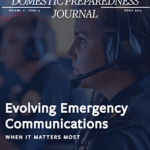Technology can be a force multiplier, such as when software guides the operations of a machine capable of performing tasks in a fraction of a second that would have required minutes if done manually. In addition, an automated product’s quality is often equal to or even an improvement over a manually produced product.
Three less common applications of technology as force multipliers involve the use of technologies to:
Significantly expand the capabilities of an individual at the moment of need through decision-support, often based on the results of data analytics;
Identify needed content and remotely deliver just-in-time instruction; and
Facilitate remote application(s) of an off-site individual’s skills to on-site personnel, enabling off-site resources to be virtually in two places simultaneously. Examples include:
Telemedicine applications provide care to patients with an illness or for mental health care; and
Child molestation investigation applications enable teleforensics conducted by a remote forensic nurse through real-time support to an on-site nurse and child in a remote or rural community.
This article focuses on the above three examples of technology for expanding capabilities to on-site workers with and without employing a real-time, rich-data communication linkage to an off-site resource(s). Solutions not involving remote human-to-human support, such as an automated decision-support system or instructional resources, are also discussed.
These force multipliers can produce practical, real-world solutions for addressing some of law enforcement’s more pressing challenges by identifying:
Narrowly focused instances where telemedicine advances are being actively leveraged in operational teleforensics applications, and
New telemedicine application support to emergency medical services (EMS) responders with the potential for enhancing on-site law enforcement personnel capabilities to process various types of crime scenes as part of their preliminary investigations.
Telemedicine and Teleforensics
Despite the substantial growth in the use of telemedicine during the COVID-19 pandemic, these solutions were not initially designed for real-time, doctor-to-patient connections between two locations. Instead, they were employed to facilitate consultations between two or more medical professionals. The core technology components of early telemedicine systems did not require high-speed Internet connections or streaming video. They were simply focused on providing a means for effective and confidential rich-data communications and file sharing between medical professionals working collaboratively on a patient’s care from two or more locations.
These earliest telemedicine exchanges were almost always accomplished without real-time discussions. Typically, the purpose of the telemedicine connection involved either a consult by a physician with a medical specialist or simply soliciting a second opinion from a fellow physician, as may have been requested by a patient or the patient’s insurance company.
Telemedicine capabilities as a force multiplier have increasing momentum in health care. Now teleforensics has new and exciting potential in law enforcement.
The technical capabilities of early telemedicine led to the first examples of teleforensics, which involved remote medical professionals who provided an expert examination of physical evidence to on-site medical personnel as well as to law enforcement officers and criminal justice system representatives at the scene. They also facilitated the collection of expert witness statements and opinions used to support their decisions regarding the appropriateness of an arrest and criminal prosecution. In the case of a child’s sexual assault investigation, for example, this remote support helped to inform the critical decision regarding the need for immediate removal of the child or children from the unsafe environment. Additionally, the complications associated with person-to-person contact related to the COVID-19 pandemic prompted a substantial change by those responsible for victim interviews to adopt an enhanced use of teleforensics as an alternative to in-person interviews in child abuse investigations.
Today, a federal grant supports the State of Texas in its use of teleforensics, providing remote specialists to assist rural health care professionals in conducting more effective sex crime investigations, especially when children are potential victims:
The Texas Teleforensic Remote Assistance Center (Tex-TRAC) was established with federal grant funding from the Department of Justice’s Office for Victims of Crime (OVC) to plan, develop, and pilot test a statewide sexual assault nurse examiner (SANE) telehealth program to serve rural and underserved communities in Texas.
One additional documented example of law enforcement’s significant reliance on teleforensics between field-level enforcement personnel and specialists at crime laboratories was included in the Congressional Justification for the Department of Homeland Security, U.S. Customs and Border Protection, Budget Overview for Fiscal Year 2021. On page 195, under the description of the activities of that agency’s Laboratories and Scientific Services (LSS), the report states:
LSS’s 24/7 Teleforensics Center (TC) provides near real-time reach back for technical advice and adjudication of presumptive screening results to field officers and agents who encounter suspect RAD/NUC threats and narcotics (chemical) threats. The TC handles on average 55 reachback calls daily and provides advice or adjudication within 30 minutes.
A “reachback” event occurs when on-site investigative personnel receive incident-specific instruction or process confirmation from off-site experts. Based on personal experiences with the implementation of an expansion of the Secure the Cities program for early RAD/NUC detection into the greater Los Angeles Area, there is the presence of shared characteristics between a reachback event and the employment of teleforensics.
Computer-Based Distance Learning at the Moment-of-Need
When the U.S. Navy began transitioning its armament of warships from large guns to precision-guided missiles, it faced some challenges related to the realignment of skill sets of onboard personnel. This problem was amplified after crew complements had been substantially reduced on modern warships over the previous era. In addition, naval ships must always be ready for warfighting, including the potential for significant casualties among their crews. As such, the Navy’s plans for maintaining adequate operational redundancies called for technical cross-training so that each sailor could perform a broad set of critical tasks well beyond their primary, day-to-day responsibilities. To achieve the required performance levels, the Navy embraced computer-based, just-in-time instruction as an essential complement to other curriculum delivery and skills practice.
Bringing Technologies Together to Support EMS
In 2017, the Public Safety Communications Research (PSCR) Division of the National Institute of Standards and Technology provided funding to the University of Virginia to support the development of “CognitiveEMS.” That sophisticated decision-support and data analytics application was designed to assist EMS personnel with identifying optimum approaches to patient care at the incident scene and throughout the patient’s transport to a hospital. A six-minute video during a 2021 PSCR virtual event demonstrated this application’s robust functionality.
While CognitiveEMS is an outstanding example of a decision-support and data-analytics application, Emory University Hospital has embraced telemedicine as part of its development of the Emory Rural Tele-EMS Network, which:
[W]ill provide telemedicine services to ambulance crews treating patients across rural Georgia. The ultimate goals of the program are to address disparities in medical care, support rural EMS personnel, and enhance access to high quality healthcare for rural patients.
All three technology components described in this article are planned for broader development over the next few years as a support system for EMS, which was defined in 2021 by the U.S. Department of Health and Human Services Biomedical Advanced Research and Development Authority (BARDA). BARDA’s Pilot Statement of Objectives for a new Resource Information Tracking and Medical Communications Application (RITCA) describes the development of a network of integrated technologies for use by EMS personnel in the field, including:
A decision-support and incident documentation system that employs data analytics to produce recommended courses of action similar to the CognitiveEMS solution;
A telemedicine application that provides a real-time, two-way rich-data connection between on-scene EMS personnel and in-hospital medical staff both at the scene and during the transport, similar to the network that Emory University is implementing; and
A computer-based distance learning system that can identify appropriate content for supporting the moment-of-need instructional requirements of on-site EMS personnel to provide optimum care as early in the patient contact process as possible.
Initially, this new network of systems will focus on providing support for EMS personnel to patients who have experienced either trauma or burn injuries. In November 2021, BARDA published an intent to enter into a sole-source contract with the Applied Physics Laboratory of John Hopkins University to build RITCA, which BARDA projected to take place over a five-year development and testing period.
Bringing Technologies Together to Support Law Enforcement
Following his 30-year career with the Los Angeles Police Department, this author served as a technical specialist for the National Center for Forensic Science (NCFS). In 2001, the NCFS submitted a grant proposal to the National Institute of Justice (NIJ) to fund the development of a Criminal Latent Evidence Advanced Recovery System (CLEARS) to support field-level law enforcement personnel with preliminary crime scene investigations. At that time, the primary conclusions reflected in that grant submission included:
A significant mismatch between desirable skill sets and critical task requirements for field-level law enforcement personnel was associated with recurring failures to identify and collect substantial quantities of available physical evidence effectively.
As a result of this mismatch, potentially critical forensic evidence for use in either the identification or prosecution of a substantial number of serious offenders was lost or undiscovered.
The incident-specific information about a crime, as derived from the preliminary investigation by the field officer, is the same set of data used by senior investigative supervisors when prioritizing additional detective resources needed for follow-up investigations, particularly when determining the seriousness as the first factor and solvability of the crime as the second factor.
The third factor of susceptibility of a particular crime scene’s circumstances to yield forensic evidence should also be considered, including but not limited to a determination of the following:
Is it a sex crime?
Was the suspect injured in any manner during the commission of the crime?
Did the victim and suspect physically struggle during the commission of the crime?
Did the suspect use a weapon, and was a firearm discharged?
Is an eyewitness or video available to allow an officer’s identification of the suspect’s path/actions?
Did the suspect consume either food or drink while at the crime scene?
NOTE: The use of data analytics for predicting the presence of latent physical evidence could begin with only anecdotal factors. However, as incident circumstances are documented over time, the accumulation of crime scene factors, actions applied, and their respective outcomes may predict outcomes from evidence-based evaluation criteria after only a few years.
The proposed CLEARS tool could address the full spectrum of support options, including:
A robust decision-support and incident documentation system, which employs data analytics to produce recommended courses of action for law enforcement personnel;
A robust teleforensics application to enable real-time, rich-data connections between on-scene law enforcement personnel and off-site subject matter experts, including options to engage detective personnel, crime scene investigation staff, or both; and
A robust distance learning system that can identify the appropriate content for supporting moment-of-need instructional requirements of on-site law enforcement personnel, including assisting in the location of and recovery of physical and latent evidence, such as blood, fingerprints, and ballistics components from a firearm’s discharge, etc.
Conclusion and Recommendations
The NIJ’s May 23, 2022, two-part “Justice Today” podcast, entitled “The Evidence We Leave Behind,” highlighted a similar but distinct field of forensic evidence research that shares many characteristics with the justice system’s employment of DNA evidence. However, instead of focusing on DNA use, these latest research efforts focus on potential forensic uses of microbial trace evidence, which involves the latent organic materials that every individual routinely deposits as each person moves around within an environment, including within the area of a crime scene. Although the deposited microbial trace evidence will not allow the specific identification of the individual perpetrator, the NIJ’s research has shown promise in using this forensic evidence as corroborative evidence.
The recently released summary of research activities conducted over the past 20 years, but especially during the past ten years, further validates the projection of an increased return on investment (ROI) from deployments of these new applications of technologies. These applications can be used at crime scenes where additional forensic evidence, especially latent evidence, can be more effectively located and collected to facilitate other suspect identifications and successful prosecutions of the perpetrators. This ROI is most prominent for crimes where a perpetrator would not have been identified without finding a cold match of DNA through the Combined DNA Index System (CODIS) or a genealogical database, or a fingerprint through the Automated Fingerprint Identification System (AFIS) or Advanced Fingerprint Identification Technology (AFIT) database.
Although technical limitations (and law enforcement culture) were not ready to support the vision of the CLEARS proposal when NCFS first submitted that system to NIJ in 2001, recent developments in several key areas have removed significant barriers to the system’s development and application of its robust capabilities. For example, advances in support technologies for field-level EMS, both currently deployed and under active development, can leverage real-time decision-support, telemedicine, and moment-of-need instruction to improve the care they provide to their patients.
Since the infrastructure elements of RITCA have a close approximation to the proposed components of CLEARS, the U.S. Department of Justice should consider the simultaneous development of a parallel system. In addition, as BARDA initially selected trauma and burn injuries as the two most pressing categories of patient illness/injury for the RITCA system, NIJ and other law enforcement stakeholders could consider sexual assaults and incidents of violent crimes (especially crimes involving the perpetrator’s use of a firearm) as an initial focus for CLEARS.
The potential market for CLEARS goes beyond U.S. law enforcement agencies, as these capabilities can also support law enforcement organizations in other countries. In addition, CLEARS can support fire/EMS agencies in arson investigations, private security’s conduct of criminal investigations, and military police and other appropriate military service branches’ investigative personnel.
In reference to the jury’s acquittal of a charged homicide defendant, Senior Los Angeles Police Department Homicide Detective Larry Kallestad appropriately stated directly to this author in 2000, “You only get the crime scene once!” Although there are individual incidents where law enforcement personnel may return to the scene of a crime in search of new evidence, this statement refers to the judicial uses of physical evidence. After a crime scene has been released, any evidence acquired from a return visit would typically be encumbered by legal complications. When officers can locate and effectively recover all pertinent evidence during the initial period when the crime scene is secured, legal complications can be significantly reduced.
The area of teleforensics has seen recent technical advances, successful prototype deployments, and well-thought-out concepts and proposals. A combination of currently planned and future government-funded initiatives can be expected soon to help institute much more capable and effective remote support systems. These advancements in technology coupled with supported initiatives will further ensure the best possible outcomes across law enforcement, EMS, and many other domains.

Michael Melton
Michael Melton, MA, MPA, retired from the Los Angeles County Department of Public Health in 2022 after more than 17 years as a senior disaster services analyst. His roles included bioterrorism and emergency preparedness, emergency logistics coordination, emergency operations, and Subject Matter Expert for Workplace Violence, as well as the lead for the agency’s Active Shooter Preparedness and Response training. Previously, he served as a U.S. Navy Midshipman, a captain in the Los Angeles Police Department, an expert witness for security and law enforcement procedures, a technical specialist at the National Center for Forensic Science, professor/instructor in criminal investigation and security at L.A. Harbor College, and security screener at Los Angeles International Airport (LAX) for the Transportation Security Administration. He holds a master’s degree in teaching/curriculum, a Certificate in Technology-Based Education, and a Master of Public Administration. The author may be contacted at mmelton1@ca.rr.com.
- Michael Meltonhttps://domesticpreparedness.com/author/michael-melton
- Michael Meltonhttps://domesticpreparedness.com/author/michael-melton
- Michael Meltonhttps://domesticpreparedness.com/author/michael-melton






